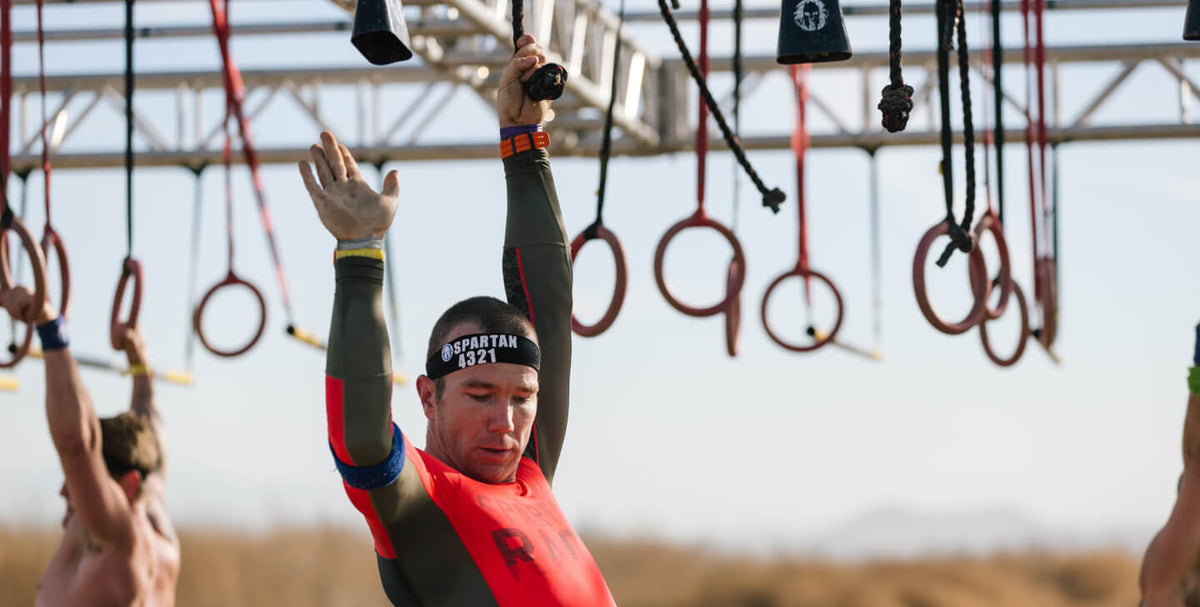Is Your Shoulder Mobility Hindering your Multirig Performance?

The multi-rig is one of the most unpredictable obstacles at any Spartan Race. Will you face only rings? Will there be ropes? How do you ever go about training for the unpredictability?
When it comes down to training for the multirig, there are two major things you can do to succeed.
- Train your Grip Strength
- Improve your Shoulder Mobility
Today we are going to discuss this second option.
Mobility is a hot topic in the Spartan community. Mobility is a fancy word which means flexibility and range of motion. We are functional athletes. Our body is required to move in every way possible regardless of if you are on your feet or if you are hanging from your hands.
We live in a society where we spend our entire day working on electronics while sitting at desks or on couches. We are all plagued with upper cross syndrome. This is when your shoulders round in, your head juts forward, and your back becomes relatively weak and inactive. This is hindering the most important component of mastering the Multirig: your shoulder mobility.
To put it rather simply, the more you can move your shoulder in every direction, the more your body can swing through whatever multirig attachment that you are facing. The more range of motion you have in your shoulders, the more momentum you can generate, the farther your reach becomes, and the greater the capacity for muscular strength.
So now let's get to the how.
How to increase your shoulder mobility:
Accumobility Releases - Spartan had the pleasure of getting a first-hand look at how Accumobility is paving the way in active mobility and functional fitness. To improve your shoulder mobility, start with the following 4 active mobility drills.
- Pecs
- Thoracic Spine
- Traps
- Lats
Arm Bar - This gravity-resisted exercise is an isometric hold which triggers your rotator cuff, allowing these relatively underactive muscles to begin to stabilize the glenohumoral (shoulder) girdle while allowing your lats to relax. Because of the position of the body, your deltoids will not become involved.
Halos:
- This exercise is gravity-assisted. You will hold a kettlebell with the bell facing up, holding around the horns with both hands. You will frame your head with the bell pointed outward, circling the kettlebell around the head and coming back to the front on the opposite side of how it started. When the bell is in the back of your head, the bell will be facing downward.
- With halos, gravity will be pulling down on the bell in the posterior position which will assist the shoulders in gaining a new range of motion in the shoulders while the lats and the traps relax. This exercise also triggers the rotator cuff allowing it to gain more strength and stability as an entire joint.
Scapular Retractions
- Scapular retractions can be done without resistance, with a resistance band, and/ or in a hanging position. This exercise is a favorite amongst rehab professionals because it plays a major part in realigning the shoulder blades, allowing them to track within their normal range, rather than winging out.
- When starting out with scapular retractions, you should begin with your back against a wall, keeping your elbows into your sides and your palms facing upward. While keeping the elbows in at your sides, turn your hands out to the sides, allowing your shoulders to act as a pivot point. The wall will become limiting; it will not allow your shoulders to wing out so your scapulas are required to retract (pinch shoulders together) in its designated fashion. When your back is against the wall, you will have a decreased perceived range of motion, but because of the limiting factor, this will be your body’s true current range of motion.
- Once the non-resisted and the banded scapular retractions are no longer challenging, you can perform a hanging scapular retraction. With this, you will hang from a pull-up bar in an overhand grip. While hanging, pull both shoulder blades together, hold for 3 seconds, and release. This will be much more difficult because of the hand position, but it will be most beneficial in opening up your shoulders and allowing a full range of motion in the hanging position needed for the Multirig.
As a functional athlete, mobility work is the most vital component of any workout you do. Our mobility work directly improves our posture and our body’s capacity to adapt to new challenges. Want to beat any Multirig you face? Become the most mobile athlete possible; improve your shoulder mobility.




